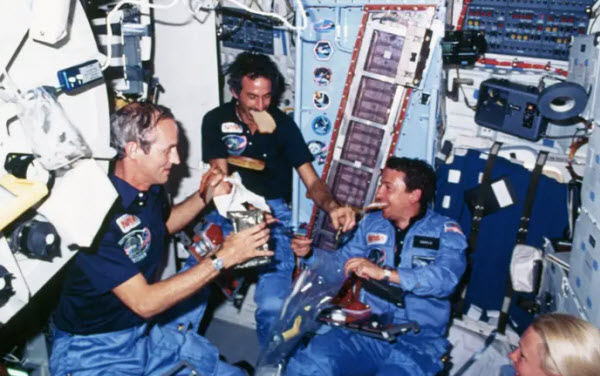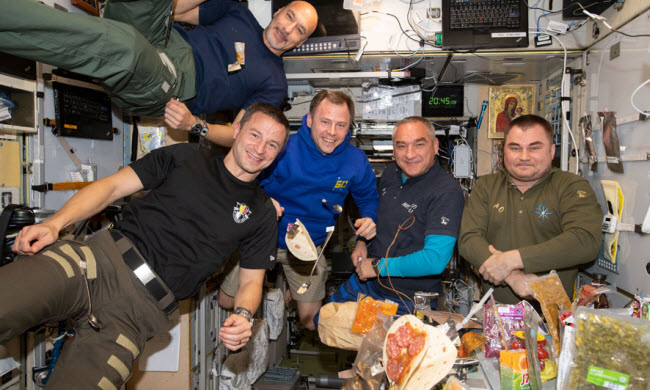In 1987, while American food scientist Vicki Kluris and her colleagues were busy inventorying the contents of the Food Systems Laboratory at NASA’s Johnson Space Center in Houston, Texas, in preparation for a move to a new location, they stumbled upon a fascinating discovery. Buried beneath tons of papers and materials was a stash of food items that had been provided to early astronauts. This included canned cheese sandwiches, bacon, biscuits, and peanut butter. Their initial decision was to discard the items, but they reconsidered and decided to take samples for analysis and preservation. This was to serve as a reminder of the significant progress NASA had made in developing astronaut food, which had initially been a considerable challenge due to the unique environment and tasks involved.
Although NASA has since made significant advances in this area, ensuring that astronaut food meets taste, nutritional value, and the proper balance of proteins, fats, and carbohydrates, the situation was very different in the past. Early scientists faced a crucial question: Can humans ingest and digest food in space? This question was answered by astronaut John Glenn in 1962 when he became the first American to eat food in space aboard the Friendship 7 spacecraft as part of the Mercury mission. His meal consisted of mashed beef with vegetables for easy chewing and apple juice, all served in tubes similar to toothpaste containers. The eating and digestion process was successfully carried out without any issues.

Over time, the method of providing astronaut food improved in terms of technology and the nature of the food itself during their missions. The Gemini program introduced freeze-dried foods through a technique developed in collaboration with NASA, a food company, and a military lab. This process involved cooking the meals to a stable temperature, freezing them, and then packaging them in a way that prevented air from causing spoilage. During the mission, astronauts would add water to the food cubes inside a bag to rehydrate and prepare them for consumption.
The improvements continued with the Apollo missions, where astronauts had access to a wider variety of foods, including parts of ready-to-eat meals provided to the U.S. military. Many Earth foods became suitable for consumption in space, and NASA approved the use of hot water to make the food less cold. The shift away from tube or freeze-dried foods allowed astronauts to enjoy chicken, vegetables, pudding, and other foods presented in a more palatable way. The first food eaten on the moon was a bacon cube, coated with gelatin to prevent crumbs from interfering with sensitive equipment, a lesson learned from a 1965 incident when astronaut John Young smuggled a beef sandwich aboard Gemini 3, leading to crumbs floating inside the spacecraft, which prompted NASA to eliminate sandwiches from future missions.

During this period, the dominant space food was thermally stable and freeze-dried to ensure a long shelf life until the construction of the first space station, Skylab, in 1973. Skylab introduced a new era of refrigerated food options, utilizing the space environment’s low temperatures to create an internal cooling room. This allowed for the storage and reheating of frozen foods, thanks to the station’s extensive solar panels. Astronauts in Skylab ate at an actual table with their feet secured to remain in place, while shuttle astronauts in the 1980s used a tray mounted on the wall and opened one food package at a time.
Within NASA, extensive consultations took place among scientists and specialists regarding astronaut food. Unlike military rations, which were high in salt and fat, space food needed to address the unique needs of astronauts working in a weightless environment, making it harder to burn calories. NASA scientists conducted numerous tests to produce special foods that would mitigate these issues while providing complete nutritional value.

With the decline of shuttle missions and the shift to long-duration flights represented by the International Space Station (ISS) starting in 1998, scientists began focusing more on creating a diverse menu for astronauts to support their nutritional and psychological well-being. Omega-3 rich, low-sodium foods helped counteract bone density loss common during space exploration. Fortunately, many of these foods were successful, though some, like soup, required careful viscosity checks to prevent floating issues. NASA developed several foods for astronauts, including freeze-dried scrambled eggs, thermally stable okra, and fajitas, which were quickly frozen, then reheated to kill bacteria before being packaged similarly to canned goods and sent to astronauts, who would reheat them in a convection oven or by adding hot water.
Today, astronaut food is no longer limited to what NASA provides alone. Astronauts can now request various other products, including store-bought sweets, as long as they have low enough moisture content to last at room temperature. NASA has also attempted to produce some of its own sweets, such as a chocolate pudding cake that was successfully reheated in four-sided ovens and was well received by station crews. Baked goods were not completely absent from missions either; in 2019, Hilton Hotels sponsored an experiment where astronauts baked cakes in space to observe how microgravity and heat affect them.

The nature of astronaut food plays a crucial role in maintaining their mental well-being during missions. During the Apollo 8 mission in 1968, astronauts were provided with turkey and thermally stable gravy on Christmas Eve to help keep them connected to Earth, even if only emotionally. Astronauts aboard the ISS often request special items from commercially packaged snacks. Occasionally, delays in supply missions from Earth force astronauts to consume leftover foods from previous missions, which, if unappetizing, can negatively affect their morale.
